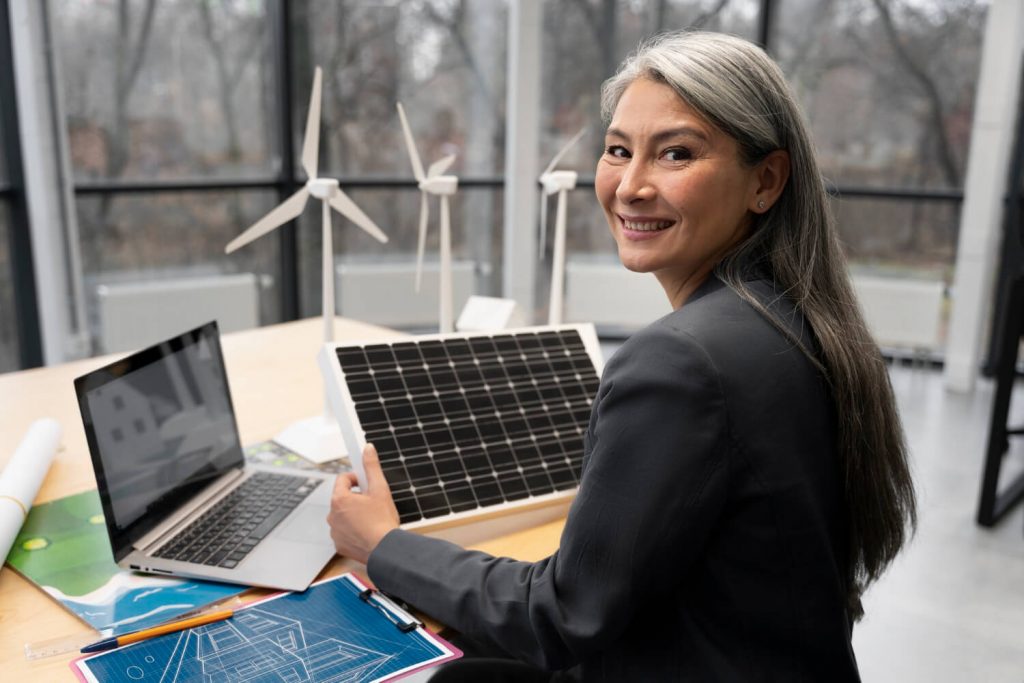Climate change has become an increasingly pressing issue in recent years, with rising global temperatures and extreme weather events impacting communities across the globe. As a result, the demand for clean energy and sustainable technologies has grown exponentially, leading to the emergence of a new industry: climate tech. However, despite its potential to drive innovation and address environmental challenges, the climate tech industry remains male-dominated. Meaning the sector still faces challenges in terms of diversity and inclusion.
The State of Women in Climate Tech and Clean Energy
According to the International Energy Agency (IEA), the energy sector has a striking lack of gender diversity, with a workforce that has 76% fewer women than men. This is a considerable deviation from the global workforce average gender gap, which stands at approximately 8%. Furthermore, women only make up 32% of the renewable energy workforce and just 22% of the workers in the oil and gas industry. A deeper analysis by IRENA reveals that the lack of gender diversity is also reflected in the renewable energy sub-sector; only 28% of STEM positions are occupied by women, in contrast to 45% of administrative jobs that are held by women.
Additionally, according to an analysis conducted in 2021 by the Organisation for Economic Co-operation and Development (OECD) and the International Energy Agency (IEA) of data collected from almost 2,500 firms in energy-related sectors reveals that women hold only 13.9% of senior management positions, with the highest representation in the utility sector. If we exclude utilities, women hold less than 12% of leadership roles. Comparatively, non-energy firms in the sample have 15.5% female representation in leadership roles out of a total of 30,000 firms analyzed.

The under-representation of women in the energy sector workforce is also evident in leadership positions, such as boardrooms, where men significantly outnumber women. Another study conducted in 2022 across 155 countries demonstrated that men hold 80% of senior management roles in the energy sector. Compared to most other industries, fewer women are hired for senior positions in energy. Specifically, women hold just 14% of senior leadership roles in the power sector and only 5% of executive board memberships.
Breaking Barriers to Women’s Participation
To address the gender imbalance in the climate tech and clean energy sectors, we must first understand the barriers that prevent women from fully participating in these industries. Some major factors are limited access to education, professional training and economic opportunities. According to the Women’s Forum for the Economy & Society, women make up more than two-thirds of the world’s 796 million illiterate people.
It is also important that women see other women succeeding in such fields to envision themselves in these roles and to understand the steps they need to take to advance. Women are significantly underrepresented in several areas of environmental decision-making globally. For instance, women hold less than a quarter (25%) of all national parliamentary positions worldwide. Additionally, women occupy only 12% of top ministerial positions in environment-related sectors globally, highlighting the underrepresentation of women in national environmental decision-making. Moreover, according to the Women’s Forum for Economy & Society, women represent only 6% of ministerial positions responsible for national energy policies and programs and 15% of Green Climate Fund Boards. This underrepresentation is also evident in district or community-level committees.
Another barrier is the lack of access to funding and investment. Data by Crunchbase reveals that just 2.3% of venture capital funding went to companies with female founders in 2020. This lack of funding makes it difficult for women-led startups to grow and compete in the market.
Finally, the tech and energy industries have historically been male-dominated, creating a culture that can be unwelcoming to women. This culture can make it challenging for women to advance in their careers, and may lead to them leaving the industry altogether.
Driving Innovation with Women in Business
Addressing these barriers is critical to driving innovation and advancing the climate tech industry. Research has shown that diverse teams are more innovative and perform better than homogenous teams. In the context of the energy and climate tech sectors, this means that a more diverse workforce can help to develop more innovative and effective solutions to address environmental challenges.

Several organizations and initiatives are working to address the gender imbalance in these industries. For example, the Clean Energy Education and Empowerment (C3E) initiative is a joint effort by the US, Canada, and several other countries to promote women’s leadership and participation in clean energy. The initiative provides recognition, networking opportunities, and other resources to women working in the field.
Another initiative is the Women in Climate Tech (WiCT) network, which provides support, mentorship, and networking opportunities to women working in the climate tech industry. WiCT also hosts events and webinars to promote the visibility of women in the sector.
Gender Balanced Transition
Gender balance is critical for achieving a successful transition to a sustainable, low-carbon economy. By breaking down the barriers that have historically prevented women from participating fully in the energy sector and investing in a diverse workforce, companies can foster innovation and drive profitability.
A gender-balanced transition in the energy sector has the potential to drive innovation, enhance business operations, and ultimately boost profits.
A study of S&P 500 Companies found that companies with above-median women representation on their management teams benefit from a 30 percent higher return on equity than their less diverse peers. Specifically, having women on boards results in a 15 percent higher return on equity.
IRENA’s World Energy Transitions Outlook 2022 report estimates that the global transition to a 1.5°C-aligned energy system could create 139 million energy sector jobs worldwide by 2030, providing an opportunity to reskill and upskill a balanced and diverse workforce. Of those jobs, 38.2 million will be in renewable energy and 74.2 million in other energy transition-related sectors such as e-mobility and energy efficiency. Women’s participation can serve as a catalyst for change and speed up the transition, leading to a win-win outcome.

Moreover, the radical transformation required to convert fossil fuel-based energy systems into more innovative, sustainable, environmentally responsible, and socially responsive systems creates emerging opportunities for women to bring diverse perspectives and support catalytic approaches. As such, the full participation of women in the energy sector is vital to achieving a successful energy transition, breaking down gender barriers, and unleashing the full potential of the workforce to drive innovation and sustainable growth. In summary, promoting gender balance in the energy sector can drive innovation, enhance business operations, and ultimately boost profits, all while contributing to a more sustainable future.
